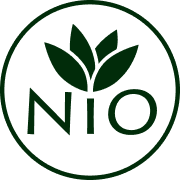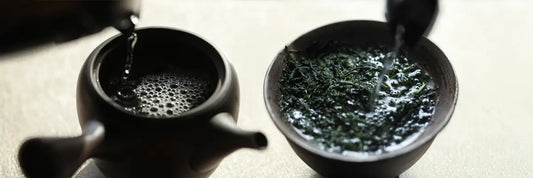The gyokuro meaning tells you a lot about the tea itself.
It is hard to answer the question what does gyokuro mean without diving into the history and the production of gyokuro tea, and that’s exactly what we’ll be doing today!
In this article, we’re going to jump back in time to find the gyokuro meaning, and we’ll also study gyokuro in Kanji to find the roots of the gyokuro definition.
Without further ado, let’s get started! 🇯🇵✍️
Gyokuro definition
By definition, a Gyokuro is a type of shaded green tea from Japan, prized as one of the most luxurious and carefully crafted teas in the world.
It differs from the standard sencha (a classic unshaded green tea) by being grown under shade for at least three weeks before harvest. This shading process transforms the chemistry of the leaves, boosting the natural theanine content and reducing bitterness, which results in its signature sweet and savory umami flavor.
The name “gyokuro” translates as “jewel dew” (or “jade dew”), a reflection of both its delicate appearance and its refined taste profile.
While most sencha is made from the common Yabukita cultivar of Camellia sinensis, gyokuro is often crafted from specialized varieties such as Asahi, Okumidori, Yamakai, and Saemidori, each contributing subtle differences in aroma, sweetness, and depth of flavor.
This combination of unique cultivation, rare cultivars, and precise processing makes gyokuro not only rare but also one of the most celebrated teas in Japan.
Gyokuro kanji

To truly understand the gyokuro definition, you need to break down gyokuro in Kanji. In Japanese, there are three writing systems. Two are phonetic, with each character signifying a syllable, and the third, Kanji, has a symbol for each word. Kanji is the only system where the symbols actually carry meaning.
How to translate “gyokuro” into Japanese?
When we look at gyokuro in Kanji, we see two characters. The gyokuro Kanji is 玉露. The character 玉 is gyoku, meaning “jewel” or “ball,” and the character 露 means “dew.” This name reflects the tea’s high quality and exquisite flavor, evoking the preciousness of jewels and the freshness of morning dew.
How the gyokuro meaning first started

In 1835, a tea merchant named Yamamoto Kahei traveled to Uji to learn about tea cultivation. He noticed that many of the families growing tea would cover the tea plants with a straw net to protect them from the cold.
The origin
He found that the tea produced by these shaded tea plants was smoother and sweeter, and he decided to conduct a few experiments on his own. After producing a few batches of these shaded teas, he noticed that the leaves produced a green residue after they were steamed. He nicknamed this “jade dew,” and that’s how we got the gyokuro meaning we have today!
There is no room for misinterpretation of the gyokuro meaning; the farmer’s intention was clear. He used the characters 玉露 for the gyokuro Kanji to label his discovery.
Artistic rather than literal
This gyokuro definition may not be a literal description of what the tea is—like kabusecha (shaded tea) or kukicha (stem tea)—but it paints the tea in more of an artistic light, which only adds to the lore of this legendary tea.
What does gyokuro mean?

Now that we’ve studied the gyokuro Kanji, we know the gyokuro definition translates to either “precious dew” or “jade dew.” To understand what the gyokuro definition means, you have to take a look at the history of gyokuro, which we will do in the next section. Let’s first explain what this tea is:
Production
Gyokuro is considered to be the most sought-after leaf tea in Japan. To be considered gyokuro tea, the gyokuro plant needs to be shaded for three weeks or more before the harvest. This improves the flavor and also increases the Gyokuro caffeine level.
Harvesting
After the shading process is complete, the farmer will select the top three leaves of the tea plant. These younger tea sprouts have the smoothest and sweetest flavor, but they are also the highest in nutrients. All of the premium Japanese green teas are made from the top leaves, and gyokuro is no exception.
Processing
After the leaves have been harvested, they are gathered up and taken through the production process. Here the leaves are steamed, partially dried, and then rolled. In order to get the tight “pine needle”-shaped leaves that gyokuro is famous for, it has to go through an extra rolling phase in a machine designed specifically for gyokuro.
Did you know that some people are even eating gyokuro leaves? To learn more about it, read our article 👉 Why people are Eating Gyokuro Leaves?
Final thoughts on the Gyokuro Definition
The gyokuro meaning doesn’t matter—what’s really important is that the gyokuro taste is great! It is sweet and savory in flavor, and the tea is loaded with caffeine, L-theanine, and antioxidants. A lot of people find that by replacing coffee with green tea, specifically gyokuro, they notice a longer-lasting calm alert sensation throughout the day, without the crash or the jitters.
If you are looking to prepare some gyokuro tea for yourself, you can try out the tea from Mr. Sakamoto. Mr. Sakamoto is a legendary farmer in southern Japan who has been growing tea without the use of pesticides since 1985. He uses his own blend of fertilizer to grow strong, flavorful tea plants without harming the natural ecosystem.




